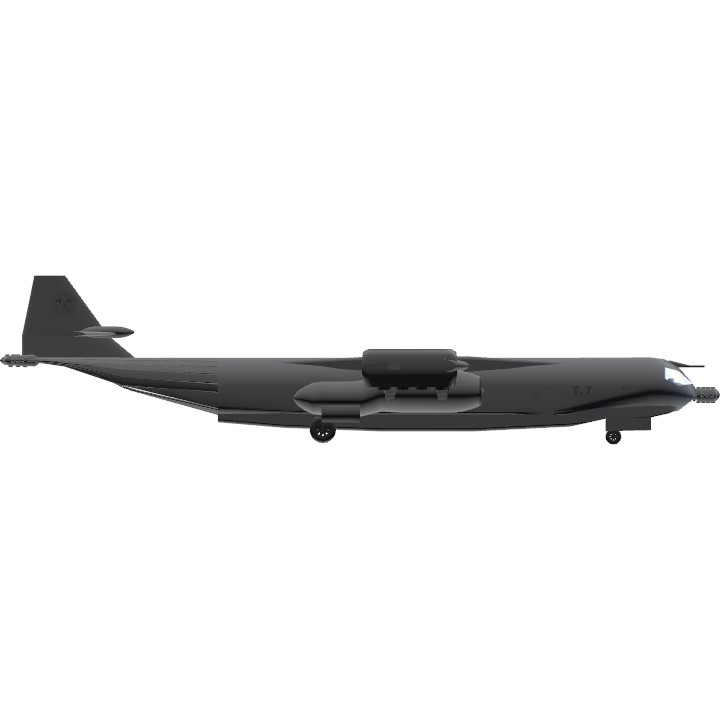Hello everyone, here's another "Transporter" aircraft for y'all. Also for anyone that saw the teaser i'm sorry this got delayed
-What is this?
This is a jet-lift transport aircraft capable of reaching speeds over 600 km/h carrying large heavy veichles and general loads consuming 3% of its fuel for a flight from Bandit to Yeager airport. It's also my first VTOL cargo aircraft.
-Controls (you can't skip this)
Here's the list:
AG1: VTOL mode
AG2: cargo door
AG3: personnel doors
VTOL lever: nozzle orientation
Trim lever: lift-jet throttle
-quick instructions
Take-off: activate VTOL mode (AG1), take trim up to 50/75% in order to stay still in the air, point the nozzles forward taking VTOL down and slowly raise the throttle. Once you reach 300/350 km/h (186/220 mph) deactivate both trim and VTOL mode
Landing: reactivate VTOL mode and take trim up to 50/75%, take the nozzles in reverse to slow down. Once you've stopped use both trim and throttle to slowly touch the ground
All of this info can also be found in the in-game instructions
-Lore (you can skip this)
The N.A.F. was in need of a new airlift aircraft since their already existing planes were slowly aging. Many builders were contacted to build the new plane. The specifications asked for a medium sized transport aircraft capable of lifting up to 2 tanks and at least 10 members of personnel while being able to land in remote areas and smaller airstrips. Most designers proposed more conventional designs, turboprop driven high wings low gear and back-door equipped aircrafts, but there was one design that stood out from the rest. It was a jet-lift transport capable of VTOL operation proposed by Markus Aircraft Manifacturer's designer "Gilbert Raymen". The N.A.F. was curious about the design and they ended up approving it seeing that It had more potential compared to the others.
Soon development started and the company managed to gain production time because the design was based on an older concept plane for a transonic naval transport. Development went pretty smooth with most of the issues coming from difficulties with the engines, landing gear and weight distribution. In fact it got its name "Fat Gilbert" because of this last issue in particular, during development engineers tried placing the center of mass as low as possible to increase stability but it was difficult only placing fuel in the wings, so they decided to give the aircraft an "underbelly" with fuel tanks. Because of this when an "overlooker" from the N.A.F. came to check how the program was going he jokingly called the aircraft "Fat Gilbert" and because the designer himself liked the name he just stuck with it. Soon the plane entered service and was loved by the N.A.F.
A total of 130 were built for the N.A.F. with another 30 being built for the N.H.O (National health organizzation) for rescue operations.
They were generally praised for their huge lifting power but there were some flaws that didn't make them last too long with them being not as fast as promised not giving advantages over a turboprop design and being extremely fuel thirsty because of their 8 huge lift-jets that made the pilot often call for areal refueling on long missions.
-Random shots



Please upvote i want to see this in the YT Live :(
Specifications
Spotlights
- This craft is curated
General Characteristics
- Predecessor AIRLIFT CHALLENGE [CLOSED]
- Created On Windows
- Wingspan 114.8ft (35.0m)
- Length 123.7ft (37.7m)
- Height 29.1ft (8.9m)
- Empty Weight 107,476lbs (48,750kg)
- Loaded Weight 172,670lbs (78,321kg)
Performance
- Power/Weight Ratio 2.967
- Wing Loading 73.9lbs/ft2 (360.8kg/m2)
- Wing Area 2,336.4ft2 (217.1m2)
- Drag Points 46054
Parts
- Number of Parts 458
- Control Surfaces 5
- Performance Cost 2,685







just realized there was a piece missing
@maddogfike wait really? I tested it a lot and i never had this issue
I like the the plane you made it's really cool it's hard to make it turn left or right but it's really fun to fly great job
@NARGII @X99STRIKER